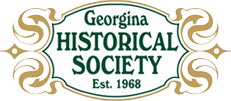Click to Download the PDF
Download the Word Doc
President’s Message
Well, summer is upon us, wow, that spring went by fast!
There’s been a lot of stuff going on, and I am sharing a story in this issue of an interesting local sub-industry that flourished at the end of the last century, operated for many years, was then closed up and forgotten until now. I hope that you enjoy the story, and I want to thank Dick and Barb Munro for bringing this fascinating story to me. It also reminds us that we must record these stories of Georgina’s past, or they will be forgotten in the rush of today’s pace.
I also want to bring to your attention the opportunity to take part in the re-awakening of the Georgina Heritage Advisory Board, disbanded a year and a half ago, and being revived to assist the consultant, Giaimo + Associates Architects, in recognizing Georgina’s heritage assets before the window closes on January 1, 2025. Contact Anna Geniole at “ageniole@georgina.ca” for more information.
I am excited about our upcoming GHS general meeting, to be held Tuesday June 18th at St. George’s Church on Hedge Road. This will be an excellent opportunity to explore this fascinating heritage site, and we will be treated to a guided tour of the grounds. I hope to see you there. Another place where you’ll see us is at the Sutton Farmer’s Market, held every Sunday morning at the Link. We did this last year with great success, and will be there again a couple of times over the upcoming summer, with some interesting artifacts and pictures to share with our visitors.
And, as always, the plea goes out to the membership for some new members to sit on the Board of Directors for the Georgina Historical Society. You can help us bring awareness to the community about the rich and unique history of Georgina. I also want to thank the existing, and former, members of the board, and of course all of our volunteers, for your dedication to the GHS. Without your participation the society could not survive.
This will be the last newsletter until September as we take a bit of a break for the summer. We are already laying plans for the upcoming general meetings in the fall, our Annual General Meeting in November is taking shape, and Harvestfest is coming up on Saturday, September 21st.
I hope that this newsletter finds you well, have a good and safe summer, and we’ll see you in the fall.
Bye for now, Paul
Paul Brady, President
The spur from the Grand Trunk Railroad to Sutton’s gravel pit on Catering Road
By Paul Brady
On Tuesday May 7, 2024 Kim and I went to visit Barb and Richard (Dick) Munro at their beautiful home on Catering Road. We had long heard of a spur line that ran into a gravel pit near the hamlet of Elmgrove, and that the gravel had been used for the construction of the original Maple Leaf Gardens. Other than that, we knew very little about it. Richard had promised to shed some light on the issue, as he had leased the land for years to pasture his herd of beef cattle, and is well familiar with it. So, on a picture-perfect spring day, we got into Richard’s truck for a full tour. He explained that the Grand Trunk railway had bought property to the west of its existing rail line into Sutton, on the north (west?) side of the river. Thus, a new bridge would not need to be constructed to reach the gravel deposit that the railway people had discovered. These deposits would have been left there as the glaciers receded 10,000 years ago. The Grand Trunk rail property, at 40 rods wide and a mile and a quarter long, was a nice sized piece of land. A rod, at 16 ½ feet, is an old measurement, and is a quarter of a chain. A chain is 66 feet long, and that measurement is still with us today as the width of a road allowance.
Richard told us that gravel and stone for the Old Toronto City Hall, built over a ten-year period from 1889 to 1899, and gravel for the original Maple Leaf gardens, built in 1931, came from this resource, so that puts its active life over a period of 40 years. I am sure that there were years of inactivity also, but it must have been a big deposit. One of the mysteries that we discussed was how did the railway people discover this deposit. The gravel is some distance from the line that runs into Sutton, and the spur line would have been fairly expensive to build, so they must have been certain of its size.

We walked the line, now on private property, as far as we could before it veered across a plowed field toward its junction with the main line. The road bed is still intact and must have been solidly constructed. Pieces of coal and cinders from shovelled out fire boxes can still be found along the trail, a direct link back to the machines that prowled this line over a hundred years ago. We also marvelled at the labour required to create just this road bed, forged through swampy land about 150 years ago.
Another story came out about a local boy who was employed to bring water to the workers as they worked the shovels and cranes. This led us to wonder about the workmen who dug the gravel, and about the steam locomotives that would have pulled that gravel back to the main line to be delivered to Toronto…such a fascinating part of our local history.
Richard then took us to another property nearby, where we learned that the original farms were laid out in rectangular plots, crossing over the Black River, and that each farm had its own bridge to access the back acreage. Amazingly, some of the piles still exist in the middle of the river, and Richard vividly recalled traversing his family’s bridge. He also told us that there were varied levels of maintenance of the bridges, and some were pretty frightening to use near the end of their usefulness. He told us of one bridge where the horses huddled together to stay as far away from the edge as possible.
On this same property is a lovely old brick house, empty now, that was built by a gentleman who was handicapped from birth. Although unable to walk and with only a basic education, he was by all accounts a very intelligent fellow, and the house was equipped with the latest conveniences of the day.
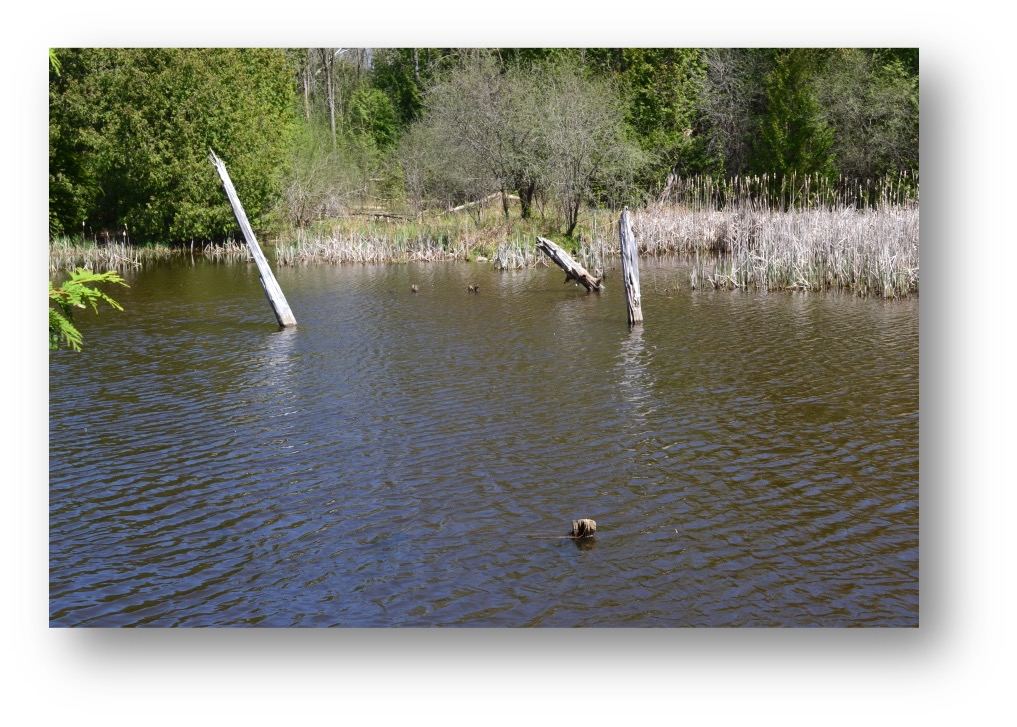
Over 100 year old pilings of farm bridge across river
We also learned about the gravel pit that is on the west side of Catering Road, to the south of Country Mile Lane. As Keswick was being built out, a source of gravel was needed. With no gravel deposits handy, The Town of North Gwillimbury bought these couple of acres, and used the gravel to build up road beds and foundations. Now dormant, the gravel pits remain, filled with spring water. This is where I recall that the big kids from Sutton went to swim during the sweltering summer days.
I want to thank Richard Munro for spending time with us to bring this interesting, and long forgotten era to our attention. I also want to thank Barb for welcoming us into their lovely home for a great visit.
The following article is adapted from a newsletter entitled Boating Blurb – Ed.
https://www.boatblurb.com/post/before-fibreglass-coming-full-circle-with-grew-boats-part-12
Grew Boats of Lake Simcoe, Ontario
An original Georgina Industry
By Richard Crowder
Arthur Grew (1885-1952) from London, Ontario learned his boatbuilding trade around the turn of the century while working at the foot of Yonge Street in Toronto for the renowned Ackroyd Brothers — builders of canoes, rowboats, and the famous Ackroyd sailing dinghy.
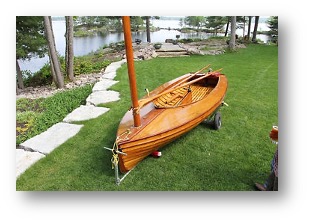
14′ Ackroyd Sailing Dinghy
In 1907, on the advice of his doctor, Grew moved to Jackson’s Point near the southern end of Lake Simcoe where he was advised that the cleaner air would be better for his asthmatic condition.
Here he set up shop and using the knowledge gained from his Ackroyd Brothers experience and built canoes, rowboats, and sailing dinghies to service the growing influx of summer cottagers and tourists from Toronto.
He also had a booming boat rental business. Sales of new boats and boat rentals increased dramatically into the 1920s as southern Lake Simcoe drew more big city vacationers with more disposable income and especially after the completion of the electric railway from Toronto to Simcoe.
But the economic crash of 1929 was devastating to many tourism-oriented businesses, and Grew suffered the downturn as well. He turned to friends for help, and one of his customers, Clarence Kemp, a successful Toronto businessman and third generation of a manufacturing and sheet metal operation known as General Steel Wares, bought the struggling company in the early 1930s. He retained Arthur Grew and his employees to run the company and stayed mostly in the background. The Jackson’s Point operation continued to build wooden canoes, rowboats, and dinghys, but on a reduced scale from before the Depression.

Fairmile ‘B Class’ Anti-Submarine Ship
Just prior to World War II, Clarence Kemp, along with a couple of Toronto businessmen, purchased the struggling Gidley Boat Company in Penetanguishene. They renamed it Grew Boats as well, but also kept the Jackson’s Point facility managed by Arthur Grew. As the war progressed, the Penetanguishene facility earned federal government contracts to build wooden bridge barges, twenty and thirty-foot tenders, and even a 140-foot minesweeper.
At the height of Canada’s involvement in WWII, Grew Boats in Penetanguishene was one of the first, along with Hunter Boats in Orillia, to receive contracts to build 8 of the 112-foot Fairmile B anti-submarine patrol boats for the Canadian Navy. This kept the operation busy and profitable until the end of the war. After the end of WWII, as the economy began to boom and discretionary spending on leisure activities increased, Grew Boats in both Penetanguishene and Jackson’s Point continued building their pre-war designs, but started offering inboard and outboard-powered runabouts and even small cruisers. A 23-foot inboard mahogany sedan was one of the most popular Grew models.
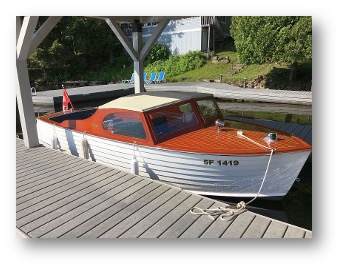
1961 Sea Coaster

1961 Sea Coaster
Both operations continued to prosper and in 1950 Kemp sold the Penetanguishene facility, along with the Grew name, to a group of Toronto businessmen headed by Col. W.E. Phillips, who docked his converted Fairmile at the plant. Arthur Grew stayed with the Jackson’s Point facility, which had to be renamed since the Grew name had been sold. It was given the new moniker Bonnie Boats and continued to build oak, cedar, and mahogany skiffs, tenders, and outboard powered runabouts. Sadly, Arthur Grew died two years later in 1952, and the Bonnie Boats facility was sold again, but continued for some years until the waterfront property was purchased for development.
Meanwhile, in Penetanguishene, Grew Boats flourished not only with their own designs, but also by producing other designs under license. Probably the best known and recognized of these licenses was obtained in 1963 to copy and produce the lapstrake outboard and sterndrive cuddy cabins and cruisers of Cruisers Inc. of Oconto, Wisconsin, which had been renamed the Thompson Boat Company. These new designs were called ‘Cruisers Inc.’ by Grew, and eventually simply ‘Grew Cruisers.’ These well built and sea-friendly designs can still be seen plying the waterways.

Fairmile ‘B Class’ Anti-Submarine Ship
Within a few years, fiberglass construction replaced wood and Grew latched on to the new technology, obtaining a license to produce Michigan-headquartered Slickcraft boats. Grew expanded exponentially, through good management and a huge dealer network, as well as a product line well suited to Canadian boating conditions. Along the way, Grew obtained licenses to produce some selected Wellcraft models and then a large complement of Chris Craft express cruiser models. Business was booming. The Penetanguishene facility doubled in size, and even arranged export of some models to the US.
However, the oil crisis of the early 1970s followed by the economic crisis of the early 80s resulted in the sale of Grew a few times over to different owners, until it eventually shut down at the end of the decade. An employee group tried to keep production going but that eventually collapsed too, leaving the remaining assets including the boat molds to be sold at auction. The molds were purchased and moved to Owen Sound where tragic circumstances eventually caused the closure of that facility in 2011, thus bringing the end to an iconic Canadian pleasure boat name.
Editor’s note: Our first family boat was an early 1970’s vintage 14’ Grew powered by a 70 horsepower Evinrude outboard motor; the family loved it!
Where in Georgina?
Our previous mystery location was identified correctly by our President Paul Brady. Thanks Paul! It’s finally solved…it was the Orchard Beach General Store! We have a new mystery location on the right …where is it, and what is it?
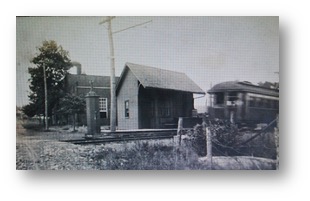
Our Pioneer Ancestors
SAMUEL KING, lot 1, concession 5, was born in England, and came to Canada in 1856. He first located at Woodstock, where he remained six years, after which he rented a farm in East Gwillimbury for ten years, subsequently purchasing a hotel at Ravenshoe, which he has since continuedto conduct. He was married in England to Miss Charlotte Short, by whom he has had eleven children, eight of whom are still living.(1)
MARK KAY, lot 7, concession 6, is the son of Joseph Kay, who emigrated from near Hull, Yorkshire, England, in 1829. Mr. Kay, sen r, married in England, his family consisted of fourteen children, twelve of whom are still living. On his arrival in York County he settled in Georgina Township, and had in the early days to go all the way to Holland Landing to the nearest grist-mill.(2)
(1) History of York Volume 2, published by C. Blackett Robinson, Toronto 1885, p.501
(2) Ibid, p.511
News Flash!!
A Win for Ontario’s Heritage
Buried at the end of May 27’s Ontario government press release was news that made ACO Chair Diane Chin’s heart sing: ACO had made huge progress in its campaign to improve protection for Ontario’s heritage!
The deadline to give full protection to non-designated properties of cultural heritage value or interest is now proposed to be extended two years, to January 1, 2027 as part of Bill 200, the Homeowner Protection Act. “Our government remains committed to ensuring that the heritage properties most important to Ontario communities are conserved and protected for generations to come,” said Citizenship and Multiculturalism Minister Michael Ford in the government media release.
ACO representatives recommended a January 1, 2030 extension at our February Heritage Day. The favourable response at those meetings encouraged an ACO Provincial Working Group to embark on several further actions. It
- conducted a survey of Municipal Heritage Committees (MHCs), in conjunction with Community Heritage Ontario (CHO), to see if MHCs were aware of and concerned about the January 1 2025 deadline (yes and yes) and if they felt they could meet it (definitely not, due to lack of expertise, lack of resources to hire experts, plus the sheer volume of work),
- sent a draft motion to MHCs to request their Council send a letter to Premier Ford asking for a January 1, 2030 deadline. ACO received copies of 20 such letters – there may be more.
- developed and circulated to ACO members a petition that individual MPPs could present in the legislature. London North Centre MPP Terence Kernaghan presented a petition on April 18, 2024. Several more petitions were in the works when May 27’s good news arrived.
- wrote several articles for CHO News. CHO in turn promoted various Municipal Heritage Committee’s strategies for tackling the listing challenge.
- alerted media about the win via a May 29 media release.
The deadline extension proposal is available for comment on the Environmental Registry of Ontario until June 26.
The above was copied verbatim from “The Acorn”, monthly newsletter of the Architectural Conservancy Ontario
News
Help!! We still need additional directors. If you are interested in playing a role in the work we are doing, don’t hesitate to contact us. Volunteers are also needed to help in the Georgina Pioneer Village – please contact Melissa Matt at 905 476 4301 ext. 2284.
Plans are well under way for this year’s Harvestfest on Saturday September 21st. Our biggest event giving prime public exposure and awareness of what we do as a society, we’re bringing in some new and interesting exhibits, demonstrations, and attractions to the event. As usual we need people to help man the buildings at Georgina Pioneer Village, and assist with the many other tasks that must be done to make this event a success. Mark this event on your calendar, and donate some of your time if possible as a volunteer. For more information contact any member of the Board listed on the contact page of this newsletter.
The Georgina Heritage Advisory Committee was disbanded after the last municipal election and for the first time since 1972 will not play a role in the Town’s plans. An engaged group of concerned citizens met April 4 to discuss this problem, and a delegation was formed to bring this situation to council. That presentation was made May 8th and its contents were reproduced in last month’s newsletter for your information. Of special concern was that the existing deadline for current heritage listings was to expire with no chance of renewal for the next five years at the end of this year. The reprinted article from Acorn’s newsletter indicates this deadline may be extended by the Provincial Government for two more years. Also an Ad Hoc Heritage Advisory Committee is to be implemented to work with the Town’s heritage consulting firm (see President’s Message for contact info).
Music in the Streets will come again to the Pioneer Village on Saturday June 22nd. Volunteers are needed for our GHS refreshment booth. Planning for Harvestfest has commenced for this upcoming September. If you can help with either event, please contact any member of the board.
Events
Saturday, June 22nd – Music in the Streets, Georgina Pioneer Village
Tuesday June 18th – General Meeting at St. George’s Church on Hedge Road. 6:30 meet & greet; 7:00 meeting
June 29th to July 1st – Canada Day week-end at Georgina Pioneer Village
August 4-6th – Civic Holiday Week-end at Georgina Pioneer Village
Saturday, September 21st – Harvestfest, Georgina Pioneer Village
